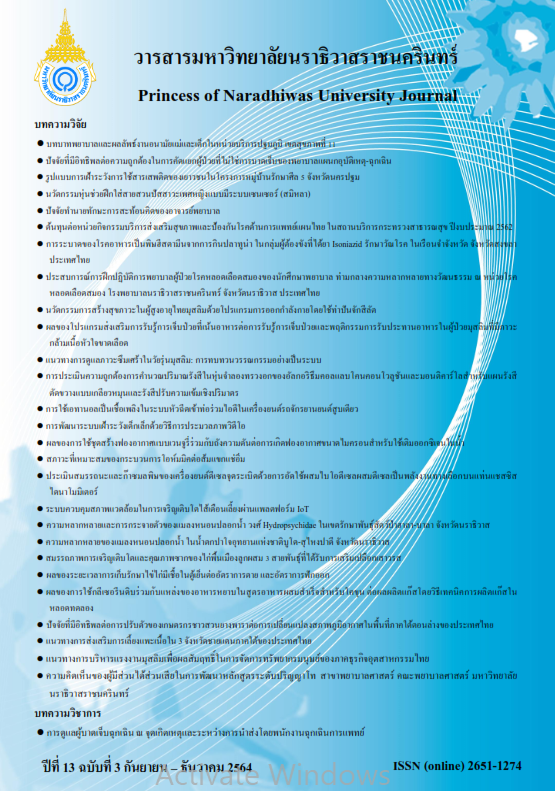The Health Promotion Innovation of Thai Muslim Older Persons by an Exercise Program with Pencak Silat Movements
Keywords:
Health promotion innovation, Exercise program, Thai Muslim older persons, Pencak SilatAbstract
This study aimed to develop an innovation to improve well-being among the older Thai Muslims using an exercise program with Pancak Silat movements. The research included 2 steps: 1) analyzing the context of the area and assessing the needs of the exercise of the older Thai Muslims. Data were collected by focus group discussion from 8 informants, selected by purposive sampling and analyzed with content analysis and 2) developing innovations to improve well-being among the older Thai Muslims through exercise programs with the Pancak Silat movements. A purposive sample of 31 older persons was selected to assess the innovation of exercise programs through the opinion assessment form. Data were analyzed by distribution of frequency, percentage, mean and standard deviation.
Acquiring Pencak Silat, the established invention resulted in 10 suitable postures with 40 minutes of exercise, using a cappella rhythm to harmonize with Thai Muslim doctrine. The exercise manual and VDO clip included two languages: Thai and a local Malay dialect. The questionnaire revealed that overall opinions in term of exercise program, and opinions in term of attitude were high ( ), ( ), and ( ), respectively. Item analysis demonstrated that Language in media received highest score in group of exercise program ( ). For attitudes, the highest score item was agreeable to folk culture ( ). This study discovered that an exercise program based on Pencak Silat is an innovative and practical exercise program that meets the needs of older Thai Muslims in three southern border provinces.
References
Boonprasert, C., Panuthai, S., & Chintanawat, R. (2016). Effect of Hatha Yoga Exercise on /Physical Fitness Among Older Persons. Nursing Journal, 43, (Supplement), 35-47.
Borg, W.R., & Gall, M.D. (1996). Educational research: An introduction. New York: Longman.
Chamnian, M., Chamnian, K., & Kaewsanit. M. (2020). The Use of Folk Performance Media to Promote the Health of the Elderly in Digital Age. Phetchabun Rajabhat Journal, 22(2), 1-8.
Chantakeeree, C. (2016). Promoting Exercise Behavior for Vulnerable Elderly. The Journal of Faculty of Nursing Burapha University, 24(2), 1-13.
Chookhampaeng, C. (2018). Curriculum Research and Development Concept and Process. //Bangkok: Bangkok: Chula book. (in Thai).
Chumuang, O., Panuthai, S., & Khampolsiri, T. (2013). Effect of Norakaag Exercise on Blood /Pressure among Older Persons with Hypertension. Nursing Journal, 40(1), 11-22.
Junwin, B., Ratchathawan, R., Dissara, W., & Thanormchayathawat, B. (2019). No-Ra-Bic: Thai Southern Art Application for Promoting Health in Elderly. Mahamakut Graduate School Journal, 17(1), 169-173.
Keawsengsai, A., Suchamvang, K., & Nanasilp, P. (2020). Effect of Iyengar Yoga Exercise on /Severity of Knee Osteoarthritis Among the Older Persons. Nursing Journal, 47(1), 175-184.
Kongpetch, C. (2019). Exercise for the elderly. Thai Journal of Nursing, 68(4), 64-71.
Natason, A., Khanthong, P., & Dechakhamphu., A. (2020). The Effect of “Rueseedutton” /Exercise Postures on Nutritional Status and Quality of Life in Older People. Rama Nursing Journal, 26(1), 90-106.
Nawai, A., Ampansirirat, A., Kosanpipat, P., Fujai, S., & Phongphanngam, S. (2020). Development of a Fon Jeng Exercise Model to Promote Physical Fitness and Psychological Well-being among Community-Dwelling Older Adults with Knee Pain. Journal of Social Science and Buddhistic Anthropology, l.5(10), 266-283.
NSO (2017). Annual report 2559. Retrieved April 12, from /https://www.nso.go.th/sites /2014/DocLib9 /yearbook2559.pdf.
Pienseethong, K., Inchan, N., & Pakdeeronachit, S. (2018). Physical Exercise Through Dance Therapy Activities for Senior Citizens in Thai Puan Community, Nakorn Nayok Province. The survey of the Conservation Observatory. The Journal of Social Communication Innovation, 1(11), 126-136.
Prasartkul, P. (2020). Situation of the Thai elderly 2020. Retrieved April 11, from http://www.dop.go.th/download/knowledge/th1610945020-322_0.pdf.
Saxon, S.V., Etten, M.J., & Perkins, E.A. (2015). Physical change and aging: A guide for helping profession (ed.6thed.). New York, NY: Springer Publishing.
Sukmee, K., Khongprasert, S., & Laohapakdee, L. (2020). The Effect of Muay Thai Exercise on Balance and Flexibility in Thai Elderly. Journal of Sports Science and Health, 21(3), 423-445.
Tohkani, D. & Tohkani, M. (2007). The Effects of Pencak Silat Exercise on Physical Performance and Satisfaction of Nursing Students, Boromarajonani College of Nursing, Narathiwat. Research Report of Boromarajonani College of Nursing, Narathiwat. (In Thai).
Vaivanjit, S., Langputeh, P., Makeng, M., Tuanbula, K., & Sulong, V. (2018). Muslin Women’s Social Space and Health Empowerment through Physical Activities amid Unrest Situation in Southernmost Provinces. Retrieved April 10, from/https://kb.hsri.or.th/dspace /handle/ 11228/ 4864.




